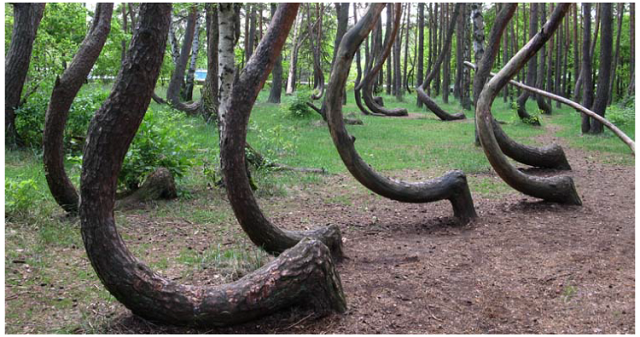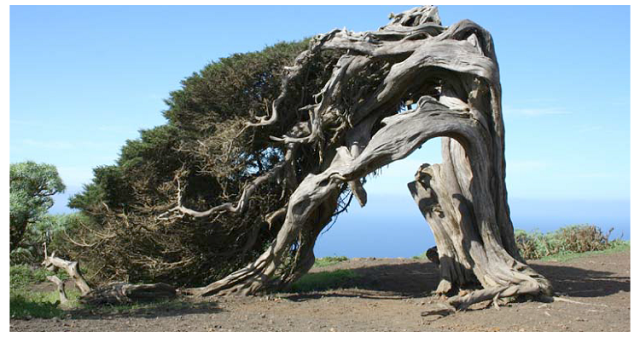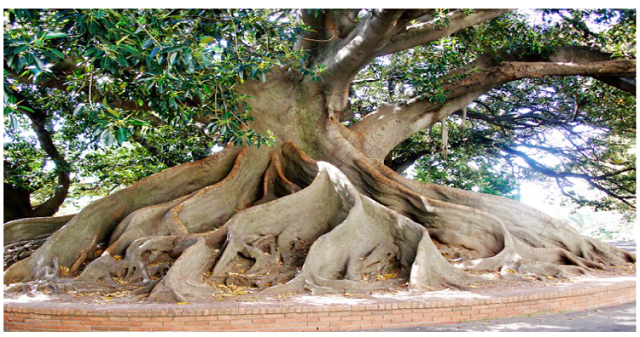Because trees are so common, we may ignore them most of the time and not pay attention to the greatness of the Creator's work in their many forms! If you think all trees are similar in shape, you will surely change your mind once you see the unique and exotic tree shapes in the article.
The strangest forms of trees that you have never seen before!
1-rainbow eucalyptus trees
Native to Indonesia, Papua New Guinea and the Philippines, Eucalyptus degloupta is a stunningly colorful tree that has earned the name “rainbow eucalyptus” thanks to its multicolored bark.
The unique coloration is caused by the way the tree sheds its bark, which first reveals the light green inner bark.
Over time, the area ages and changes color, turning into different shades of maroon, orange, purple, and blue.
The different layers fall off and age at different times, creating a gorgeous pattern.
The tree has many other great features. For example, it grows from 197 feet to 246 feet in height, and has a trunk diameter of 94 inches.
It is also one of the four eucalyptus species found outside Australia, where there are more than 700 species of this tree.
2-The Twisted Tree Forest of Griffino
One of the strangest forests that includes the strangest forms of trees. The forest is famous for the unique and peculiar shape of the pine groves that were planted around 1930.
All of the 400 pine trees in the forest have a twisted, J-shaped trunk, all of which bend back upright to reach a height of nearly 50 feet.
No one knows exactly why trees grow so abnormally, but several theories have emerged despite the lack of evidence to support their validity.
Some have assumed that the growth of trees curving to the north was caused by the strange force of love in the area. However, this theory contradicts the proven scientific fact that gravity has a downward pull on the Earth that never causes trees to bend.
Others speculated that heavy snowfall caused it to warp, but this theory also failed because no other trees were visible in the same area of influence.
However, the most plausible and credible explanation is that the locals used some kind of tool to warp the trees in this way to produce curved wood that could be used to build boats or furniture.
3-Canary Islands Dragon Trees
Dracaena Draco, known as the "Canary Islands Dragon Tree", is known for its umbrella-like shape.
Native to the Canary Islands, Madeira and Cape Verde, this subtropical tree belongs to the asparagus family.
Dracaena draco plants grow slowly, and can take about ten years to grow four feet tall. Being monocotyledonous, Canary Islands dragon trees do not have the annual or growth rings commonly found in other trees.
This is why the age of these trees is determined by looking at the number of branching points that reach the canopy. The oldest living specimen called "El Drago Milenario" or "thousand-year-old dragon" can be found at Icod de Los Vinos in Tenerife. It is believed that the estimated age of this tree is about 365 years.
4-La Sabina tree in Spain
La Sabina is the name given to a strangely deformed tree found in El Hierro, one of the Canary Islands.
This type of tree can grow in the harshest places. When growing in areas with strong winds, the tree twists and its trunk is deformed.
Although the trunk remains straight, the branches bend to touch the ground, creating the famous odd shape.
5-Wonna tree or tunnel
Also known as the tunnel tree, it was in Yosemite National Park until February 1969. This giant sequoia tree was nearly 227 feet tall and 26 feet in diameter around the base.
In 1881, a tunnel was cut through the huge tree trunk, and the site quickly became a popular tourist attraction where people come to take pictures of their cars passing through the tunnel.
In 1969, a heavy load of snow caused the giant tree to fall. At the time, it was estimated to be 2,300 years old.
There was a lot of debate about what to do with the tree after it fell, but the authorities decided to keep it where it fell for environmental reasons.
People still visit the site, now known as the "Falled Tunnel Tree".
6-The Tree of Life in Bahrain
It is a 32-foot-tall mesquite tree that stands on a hill in the arid Arabian desert. Although there is no visible water source around, the tree has managed to thrive, baffling scientists and visitors alike.
The 400-year-old tree contains a large amount of water in its complex root system, which reaches a depth of 50 meters underground.
While this may help it access a water source, others speculate that the tree has learned to squeeze moisture from the grains of sand.
Over the years, the Tree of Life has become a popular tourist attraction, and about 65,000 people visit the site each year.
7-Ponderosa pine trees
Ponderosa pine is a species of very large pine tree. These massive trees grow up to 200 feet and have huge trunks three to four feet in diameter.
It grows mostly on dry mountain slopes, and is easily recognizable by its straight, long, thick trunks, and rusty orange bark.
You can also identify the tree by smelling its bark, which has the scent of butterscotch or vanilla.
Giant trees are 500 years old or more. These pines are known for their heavy wood, and are a major source of lumber in the southwestern United States.
8-Axel Erlandson Art Trees
Axel Erlandson, a Swedish American farmer, was famous for shaping trees as a hobby. In 1947, he opened a gardening attraction called "The Tree Circus". It was advertised as a place where you can see “the strangest tree shapes in the world.”
Through a natural phenomenon called "endoscopy", trees naturally feed themselves. When he realized this, Erlandsson began experimenting with trees that were intentionally grafted together to create intricate shapes.
Forming, grafting and pruning trees took years of work, but the result was satisfactory.
In 1985, Michael Bonfant, owner of Nob Hill Foods, bought these wonderful trees and planted them in his amusement park called Gilroy Gardens. The trees are still there today for all to enjoy.
9-Baobab trees
Native to Africa and Madagascar, baobabs are deciduous trees belonging to the genus Adansonia. The baobab is also known as the "upside-down tree", and is famous for its impressive size.
They reach 16 to 98 feet tall, with trunks 23 to 36 feet in diameter. Their incredibly strong trunks can store up to 32,000 gallons of water, helping them survive in harsh drought conditions.
The hollow trunk of a baobab tree can be so huge that about 40 people can take cover inside. Large baobab trees have been used as prisons and homes in the past.
10-Trees with supportive roots
Pillar roots are basically broad, large roots that stick out from all sides of shallow-rooted trees. These trees are commonly found in tropical forest soils that lack the necessary nutrients.
The massive roots not only help the tree gather more nutrients, but also prevent it from falling. The rhizomes of the pillar can grow up to 30 feet in height and spread 30 meters above and below the ground.
8 luxury homes and palaces that no one wants to buy, even if they are free











